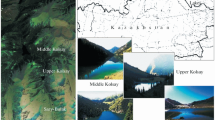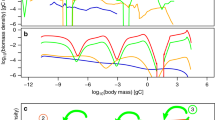Summary
Data from Mirror Lake, New Hampshire, are used to construct the first quantitative description of the size structure of a freshwater benthic animal community. Size spectra of the benthic animal community, whether expressed as animal density, biomass, species richness, or assimilation, are generally unimodal. These spectra are strikingly different from the characteristically bimodal size spectra reported for marine benthic communities. There is no indication in these size spectra that the meiofauna and macrofauna are distinct ecological entities in Mirror Lake, as has been suggested for marine benthic communities.
Similar content being viewed by others
References
Andrassy I (1956) Die Rauminhalts- und Gewichtsbestimmung der Fadenwürmer (Nematoden). Acta Zool 2:1–15
Banse K (1982) Mass-scaled rates of respiration and intrinsic growth in very small invertebrates. Mar Ecol Prog Ser 9:281–297
Banse K, Mosher S (1980) Adult body mass and annual production/biomass relationships of field populations. Ecol Monogr 50:355–379
Dumont H, van de Velde I, Dumont S (1975) The dry weight estimate of biomass in a selection of Cladocera, Copepoda, and Rotifera from the plankton, periphyton, and benthos of continental waters. Oecologia (Berlin) 19:75–97
Goodman KS (1980) The estimation of individual dry weight and standing crop of harpacticoid copepods. Hydrobiologia 72:253–259
Hamilton AL, Burton W, Flannagan JF (1970) A multiple cover for sampling profundal benthos. J Fish Res Bd Canada 27:1867–1869
Kajak Z, Bretschko G, Schiemer F, Leveque C (1980) Zoobenthos. In: LeCren ED, Lowe-Mc Connell RH (eds) The functioning of freshwater ecosystems, Cambridge University Press, Cambridge, pp. 285–307
Kerr SR (1974) Theory of size distribution in ecological communities. J Fish Res Bd Canada 31:1859–1862
Likens GE (ed) (1985) An ecosystem approach to aquatic ecology: Mirror Lake and its environment. Springer-Verlag, New York
McIntyre AD (1969) Ecology of marine meiobenthos. Biol Rev 44:245–290
Moeller RE (1975) Hydrophyte biomass and community structure in a small, oligotrophic New Hampshire lake. Verh Int Verein Limnol 19:1004–1012
Moore JW (1979) Some factors influencing the distribution, seasonal abundance and feeding of subarctic Chrironomidae (Diptera). Arch Hydrobiol 85:302–325
Pearre S (1980) The copepod width-weight relation and its utility in food chain research. Can J Zool 58:1884–1891
Peters RH (1983a) Size structure of the plankton community along the trophic gradient of Lake Memphremagog. Can J Fish Aq Sci 40:1770–1778
Peters RH (1983b) The ecological implications of body size, Cambridge University Press, Cambridge
Reise K (1979) Moderate predation on meiofauna by the macrobenthos of the Wadden Sea. Helgoländer wiss Meersunters 32:453–465
Roback SS (1969) Notes on the food of Tanypodine larvae. Entomol News 80:13–19
Robinson WR, Peters RH, Zimmerman J (1983) The effects of body size and temperature on metabolic rate of organisms. Can J Zool 61:281–288
Schwinghamer P (1981) Characteristic size distributions of integral benthic communities. Can J Fish Aq Sci 38:1255–1263
Schwinghamer P (1983) Generating ecological hypotheses from biomass spectra using causal analysis: a benthic example. Mar Ecol Prog Ser 13:151–166
Sheldon RW, Prahash A, Suteliffe WH (1972) The size distribution of particles in the ocean. Limnol Oceanogr 17:327–339
Sheldon RW, Sutcliffe WH, Paranjape MA (1977) Structure of pelagic food chains and relationship between plankton and fish production. J Fish Res Bd Canada 34:2344–2353
Sprules WG (1984) Towards an optimal classification of zooplankton for lake ecosystem studies. Verh Int Verein Limnol 22:320–325
Sprules WG, Casselman JM, Shuter BJ (1983) Size distribution of pelagic particles in lakes. Can J Fish Aq Sci 40:1761–1765
Strayer D (1985) The benthic micrometazoans of Mirror Lake, New Hampshire. Arch Hydrobiol Suppl 72:287–426
Strayer D, Likens GE (1986) An energy budget for the zoobenthos of Mirror Lake, New Hampshire. Ecology 67:303–313
Walter RA (1976) The role of the benthic macrofauna in the structure and function of the Mirror Lake ecosystem. Thesis, Cornell University, Ithaca, New York, USA
Walter RA (1985) Benthic maroinvertebrates. In: Likens GE (ed) An ecosystem approach to aquatic ecology: Mirror Lake and its environment, Springer-Verlag, New York, pp 204–228
Warwick RM (1984) Species size distributions in marine benthic communities. Oecologia (Berlin) 61:32–41
Waters TF (1977) Secondary production in inland waters. Adv Ecol Res 10:91–164
Author information
Authors and Affiliations
Rights and permissions
About this article
Cite this article
Strayer, D. The size structure of a lacustrine zoobenthic community. Oecologia 69, 513–516 (1986). https://doi.org/10.1007/BF00410356
Received:
Issue Date:
DOI: https://doi.org/10.1007/BF00410356




